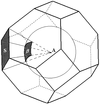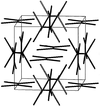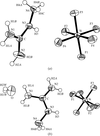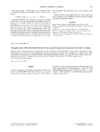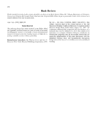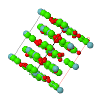issue contents
April 1999 issue

Cover illustration: An infinite hydrogen-bonded sheet in guanidinium trifluoromethanesulfonate. Courtesy of C. B. Aakeröy [Acta Cryst. (1997), B53, 569-586; structure determined by V. A. Russell, M. C. Etter & M. D. Ward].
research papers
The coordination numbers of Be, Mg and alkaline earth atoms were determined using Voronoi–Dirichlet polyhedra in the crystal structures of about 2100 inorganic and organometallic compounds. The volume of the domains of Mg, Ca, Sr and Ba atoms was found to be independent of their coordination numbers.
A program and database to find crystal structure types of inorganic compounds has been developed.
Download citation


Download citation


The crystal structure of heptabismuth tritantalum octadecaoxide, Bi7Ta3O18, has been solved and refined using single-crystal X-ray data and corroborated by powder neutron diffraction data. The structure is based on dislocated layers of the fluorite type. The metal populations are fully ordered, with TaO6 octahedra forming columns amid variously coordinated Bi and O atoms in distorted fluorite positions.
Download citation


Download citation


Iodo-oxyapatite, Ca15(PO4)9IO, was synthesized by a flux method. The unit cell is tripled owing to ordering of the iodide and oxide ions.
The projection symmetry observed in high-resolution electron micrographs of hydroxyapatite is p3 and not p6, which would be compatible with the accepted space group  . This is attributed to dehydration of hydroxyapatite in the microscope under the electron beam, giving rise to oxyapatite. The crystal structure of oxyapatite was elucidated from the electron micrographs.
. This is attributed to dehydration of hydroxyapatite in the microscope under the electron beam, giving rise to oxyapatite. The crystal structure of oxyapatite was elucidated from the electron micrographs.
A systematic search over the Pnma structures in the Inorganic Crystal Structure Database results in the detection of 58 substances with very strong pseudosymmetric features that suggest the existence of a Landau-type phase transition at higher temperatures.
Download citation


Download citation


The mixed-valent MnIII,IV complex ion in the title compound has crystallographically equivalent Mn sites because of disorder about a crystallographic twofold axis passing through the bridging oxo ligands.
The complementary views of chemical bonding provided by charge and momentum densities are described and their application to the possible mechanism of insertion of metal atoms in molecular crystals is considered.
The conformational behaviour of [M2{μ-PPh2}] species, studied by database and computational methods, shows that experimental geometries lie within 8 kJ mol−1 of the global minimum. Phenyl ring rotations occur by both coupled disrotatory and uncoupled conrotatory motions of the two P—Ph rotors.
Download citation


Download citation


A single-crystal neutron diffraction study of 2-methyl-5-nitroaniline at 100 K has been performed at ISIS in order to establish the degree of planarity of the amino group and to add to the understanding of the role of hydrogen bonds in the molecular organization of nitroanilines.
Crystals of cinnamic acids and esters were found to consist of almost planar layers kept together by intermolecular C—H⋯O hydrogen bonds of various types. Intramolecular C—H⋯O hydrogen bonds render synperiplanar and antiperiplanar C=C—C=O arrangements equally possible in the acids, but fix exclusively a synperiplanar conformation in the esters.
Download citation


Download citation


The crystal structure and spectral data for a new compound, Lys.3HIO3, are reported.
Download citation


Download citation


The crystal structure, thermal vibrations and electron density of N-acetyl-L-tyrosine ethyl ester monohydrate, C13H17NO4.H2O, have been analysed using single-crystal 110 K X-ray diffraction data collected using a CCD area detector during one week. This work shows that area detectors permit charge density studies in a more routine way than is possible with conventional diffractometers.
Download citation


Download citation


The structural features of 4-(4-halobenzylideneamino)TEMPO radical crystals and related compounds can be classified into three groups. The relationships between the crystal structures and the mechanism of the intermolecular magnetic interactions are discussed.
Download citation


Download citation


The structures of CH8N4SiF6 and (CH7N4)2SiF6·2H2O, new materials formed as by-products in the course of preparing ferroelectric CH8N4ZrF6 in the presence of glassware, are reported for comparison with the corresponding hexafluorozirconates. The packing efficiency in CH8N4SiF6 is appreciably higher than in the dihydrate, which has an ∼8% increase in void space.
short communications
A new trace 114R SiC in commercial α-SiC powder has been identified by HREM. Its stacking sequence is [(33)4(34)2]3, belonging to the structural series (33)>n34(33)>m34 predicted theoretically by Pandy & Krishna [Mater. Sci. Eng. (1975), 20, 243–249].
An error in printing in the paper by Pani et al. [Acta Cryst. (1998), B54, 872–876] is reported.
books received
Free 



 journal menu
journal menu








